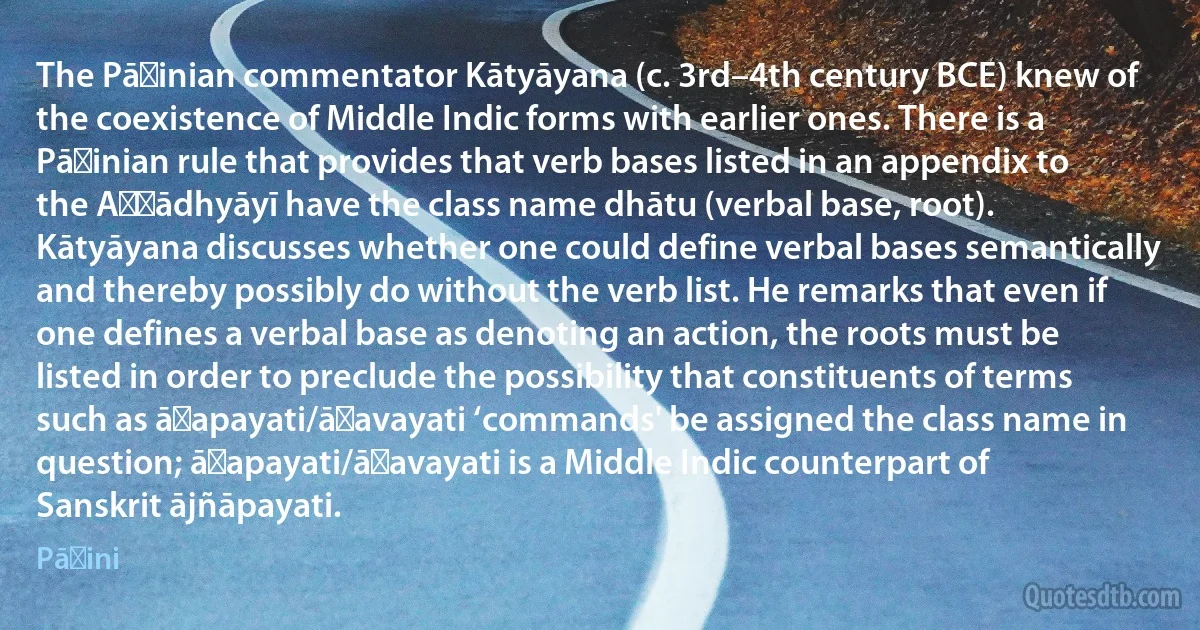
The Pāṇinian commentator Kātyāyana (c. 3rd–4th century BCE) knew of the coexistence of Middle Indic forms with earlier ones. There is a Pāṇinian rule that provides that verb bases listed in an appendix to the Aṣṭādhyāyī have the class name dhātu (verbal base, root). Kātyāyana discusses whether one could define verbal bases semantically and thereby possibly do without the verb list. He remarks that even if one defines a verbal base as denoting an action, the roots must be listed in order to preclude the possibility that constituents of terms such as āṇapayati/āṇavayati ‘commands' be assigned the class name in question; āṇapayati/āṇavayati is a Middle Indic counterpart of Sanskrit ājñāpayati.
PāṇiniRelated topics
action appendix base century coexistence commentator counterpart define early middle name ones order possibility question root rule rootsRelated quotes
A common monetary standard will be established, with the consent of the various governments, by which industrial transactions will be greatly facilitated. Three spheres made respectively of gold, silver, and platinum, and each weighing fifty grammes, would differ sufficiently in value for the purpose. The sphere should have a small flattened base, and on the great circle parallel to it the Positivist motto would be inscribed. At the pole would be the image of the immortal Charlemagne, the founder of the Western Republic, and round the image his name would be engraved, in its Latin form, Carolus; that name, respected as it is by all nations of Europe alike, would be the common appellation of the universal monetary standard.

Auguste Comte
People like to do things. They like to do them well. People take the dangerous, hard jobs because they take pride in doing them, they can-egoize, we call it-show off?-to the weaker ones. Hey, look, little boys, see how strong I am! You know? A person likes to do what he is good at doing.... But really, it is the question of ends and means. After all, work is done for the work's sake. It is the lasting pleasure of life. The private conscience knows that. And also the social conscience, the opinion of one's neighbors. There is no other reward, on Anarres, no other law. One's own pleasure, and the respect of one's fellows. That is all. When that is so, then you see the opinion of the neighbors becomes a very mighty force.

Ursula K. Le Guin
That cult would never die till the stars came right again, and the secret priests would take great Cthulhu from His tomb to revive His subjects and resume His rule of earth. The time would be easy to know, for then mankind would have become as the Great Old Ones; free and wild and beyond good and evil, with laws and morals thrown aside and all men shouting and killing and revelling in joy. Then the liberated Old Ones would teach them new ways to shout and kill and revel and enjoy themselves, and all the earth would flame with a holocaust of ecstasy and freedom. Meanwhile the cult, by appropriate rites, must keep alive the memory of those ancient ways and shadow forth the prophecy of their return.

H. P. Lovecraft
Outwardly Eisenhower impressed me favourably. On June 5 Eisenhower, Montgomery and de Lattre de Tassigny arrived in Berlin to sign the declaration on the defeat of Germany and the assumption of supreme authority in Germany by Governments of the USSR, the US, Britain and France. Before the formal meeting, Eisenhower came to my headquarters to confer upon me a high American military award: I was made Chief Commander of the Legion of Merit. On receiving the award, I immediately called Stalin and told him about it. Stalin said: "We should decorate Eisenhower and Montgomery with Orders of Victory and de Lattre de Tassigny with the Order of Suvorov, First Class." "May I tell them about it?"

Georgy Zhukov
English: Only a total idiot would think that a major channel is working to inform the audience. The channel sells product, it must be packaged. CNN, for example, is a colossal ideological tool in the West. An excellent example is the situation around Yugoslavia. How effectively a very civilized part of humankind was brainwashed! The question is in approaches. If a consumer "grubs" stale bread, nobody will offer him poppy-seed buns. I'm an absolutely engaged person. By myself. I have certain political views. I'm not a journalist. I practice political propaganda. I am a commentator, and if one comments on events without having one's own position, that's an unhealthy symptom.

Mikhail Leontyev
